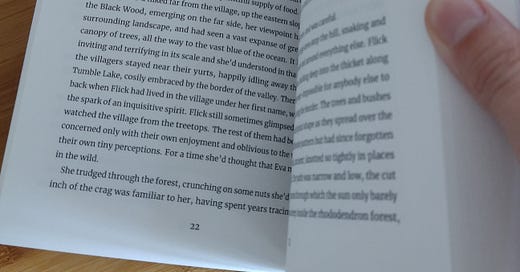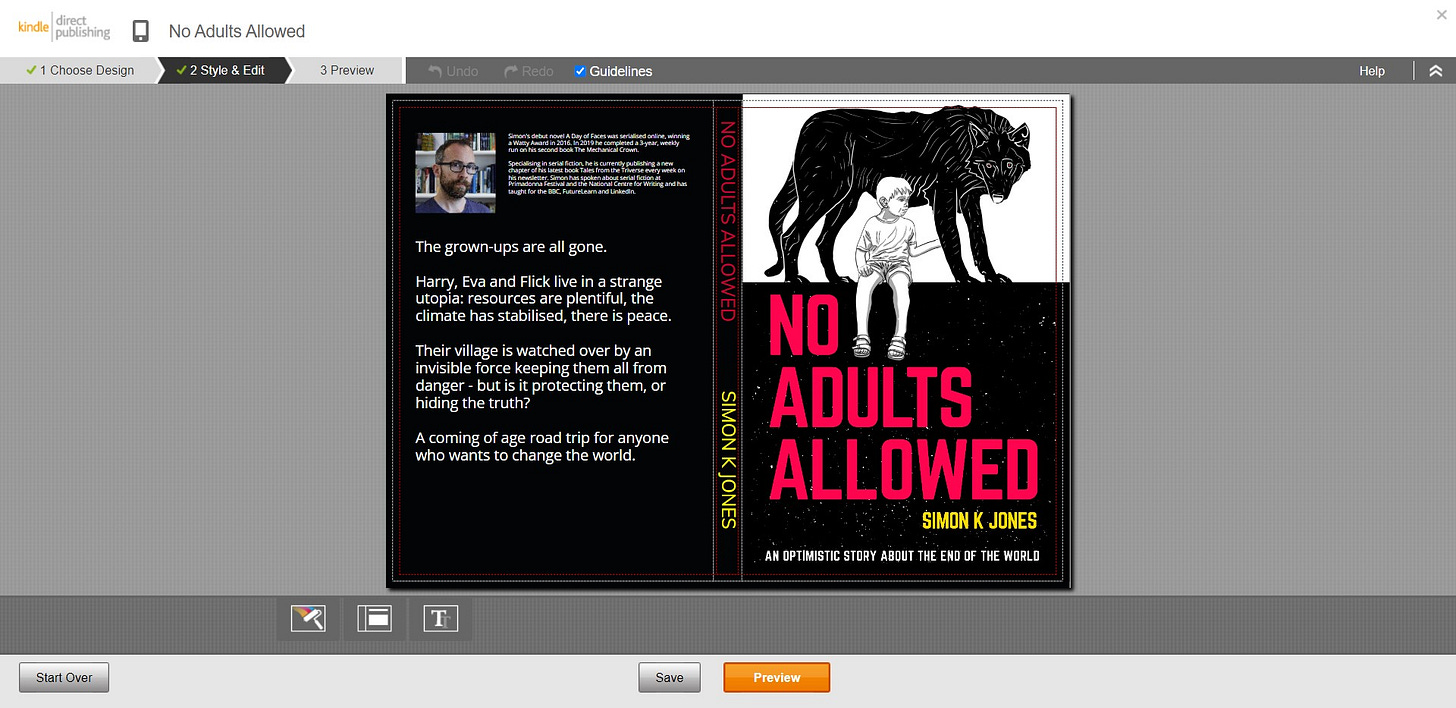I’ve been so focused on writing and publishing weekly chapters for the last seven years that I’ve rather overlooked other opportunities to do interesting things with my work. Such as publishing the finished manuscripts in other forms.
Spending time with other writers tends to give me a kick up the backside, I find, and prompts me to look at what I’m doing from different perspective: that’s what happened recently, while having coffee with AE Warren, when she asked what I was doing with my back catalogue.
Cue a blank stare.
The way in which I write is all about forward momentum. Write, publish, write publish. It helps keep me consistent and productive. This years has also been about looking back at what I’ve done previously, and thinking about what else could be done. Two of my completed books, A Day of Faces and The Mechanical Crown, have been taken into Wattpad’s Paid Stories catalogue, which limits when I can do with them for the duration of the contract (which makes sense - they’re essentially granted exclusive publishing rights.
Then there’s No Adults Allowed, my YA adventure novel that I wrote during the 2020 lockdowns. It’s a shorter book, more focused, and it’s gone through more revision. My mind made up, I began the process of figuring out how to self-publish.
Distribution options
There are a dizzying number of options for self-publishing a book. There’s always been two that jump out from the rest, though: IngramSpark and Amazon KDP.
The latter is the big, obvious one that has essentially cornered the market. Amazon’s self-publishing tools are remarkably easy and fast, but it more-or-less restricts your market to Amazon itself. Ethically that could be a problem.
IngramSpark allows for wider distribution, into other ebook stores and also into brick-and-mortar bookshops and libraries. Very tempting, in other words, but also additional complexity.
As this is my first attempt to do this I opted for Amazon KDP as a starting point: I can always expand through IngramSpark at a later date. Amazon KDP handles ebooks and print, with a variety of production options. This is a YA novel and I’m a relatively unknown writer, so I wasn’t going to create a luxury hardback: this is a paperback page turner all the way.
In an ideal world I’d be working with designers, but that’s a bit beyond my budget currently. This was always going to be a DIY job.
Preparing the interior
I write in Scrivener, which is a phenomenal tool for writers. It’s less good at producing production-ready manuscripts, though. I wanted the No Adults Allowed ebook to look as close to a professional book as possible.
On Mac there’s an app called Vellum which everyone raves about. Alas, I don’t have a Mac, so had to look elsewhere for typesetting and layout. That led me to Reedsy, a freelance marketplace for all things book-related. It’s the place to go to find editors, designers, translators and so on. It also happens to have its own tool for prepping book interiors.
After moving the manuscript from Scrivener into Reedsy and making the necessary adjustments - checking chapter breaks, inserting scene breaks and so on - I was able to export an ebook file and a PDF for printing, both of which are compatible with Amazon KDP’s systems.
The book cover
The No Adults Allowed over has gone through all sorts of changes since 2020. Here’s a quick gallery:
This was the original cover that accompanied the book’s initial run on Wattpad. I thought it was very clever, taking the door sign that kids like to hang on their bedroom doors and putting the title on it. Unfortunately it wasn’t representative of the setting, so was never a good match.
To address that issue I started pulling out specific themes and visuals from the book, such as a young boy and a wolf. The version above is only a mock-up, with me trying to figure out composition through some photobashing.
I quite liked the way the landscape split the cover in half, and started playing around with some thumbnails in that direction:
This was when I was thinking of having multiple characters represented on the front. For a while I had the wolf dissolving into particles:
The layout there is bad, and the art style is practically screaming I’M SELF-PUBLISHED! I toned it down to this:
Getting there. The final thing was to improve the typography, which had never really worked properly. Eventually after much fiddling around I ended up with this:
That’s the final version of the cover which I’m using for print and ebook. I’ve no doubt that a professional designer would do something better, but I’m happy with where this has ended up. The addition of the tagline at the bottom seems to help, as well.
Amazon have a built-in cover editor. It’s ugly and rudimentary but does the job, with the added benefit of guaranteeing that everything will align properly to the print edition. You could of course do your layout in Photoshop or similar.
During the cover creation process I used a few different tools, primarily Clip Studio Paint for the illustrations and Canva for the main layout.
Getting a proof
The ebook is fairly straightforward: interior plus front cover image. It also can be updated at any time, even after release. The print version is trickier in that it has to be right: I don’t want to be sending out glitchy books. That’s what proofs are for, and I had Amazon send me one as soon as I’d finished setting up the book.
It took about five days to arrive:
Being a writer who has published all of their material online, I wasn’t prepared for the visceral thrill and unarguable reality of holding a physical book in my hands. The magic of taking words that only existed digitally on screens and willing them into existence is quite the thing.
I wrote a book! Somehow holding the book makes that seem more real.
The print quality is good, too. Not quite as good as the best productions from the Big 5, but entirely satisfying nonetheless. If I’d bought this thing, I’d be perfectly happy. Clear text, high quality reproduction of the cover. Maybe a bit more flex in the outer card than I’d like, but there’s a nice, waxy matte feel to the thing.
Final polishing
There’s more work to be done, inevitably. A consequence of having the text in a brand new form is that I start to see it with fresh eyes. As such, I’m doing a final pass on the manuscript before publishing. This is mostly checking for errors, but I’m also making small tweaks here and there to sentence structure. Nothing major, but it’ll lift the quality overall.
I’m aiming for a release around late October. I’ll be talking more about the book itself closer to the time, in case you are wondering if it’s your sort of thing.
In other news
Meanwhile, in Norwich. If you happen to live near to me and have an 11-13 year old in your life, I’m teaching a workshop on writing science fiction and fantasy at the National Centre for Writing next month. Details here. It’s going to be fun.
See you on Friday for the next Triverse chapter.















That cover is spot on.
I did like the cover version where the wolf dissolved as a foreshadowing of *SPOILER* the nanotech nature of it, but the "Boy and his Dog" image - in any version - is absolutely the right basic concept.
As I said on FB, I love that tag line. Again, perfection.
Some good and useful information in this article. Thanks!
Once we've moved to our final location I'll be adding this to my bookshelf.
I'm smiling, remembering the times when I've held physical copies of my own work. The utter surprise when my first story sold (a friend of mine submitted it to the magazine, so, literally the first I knew about it was when the magazine arrived in the mail with my check), the thrill of walking into a game shop a thousand miles from home and buying a different magazine with my work in it, the box I have full of all my articles for OC Weekly, buying my band's CD in a store - to this day that copy is shrink wrapped with the price sticker on it. Feels great!
NAA is a well done story. I hope the ebook/physical print finds an audience.